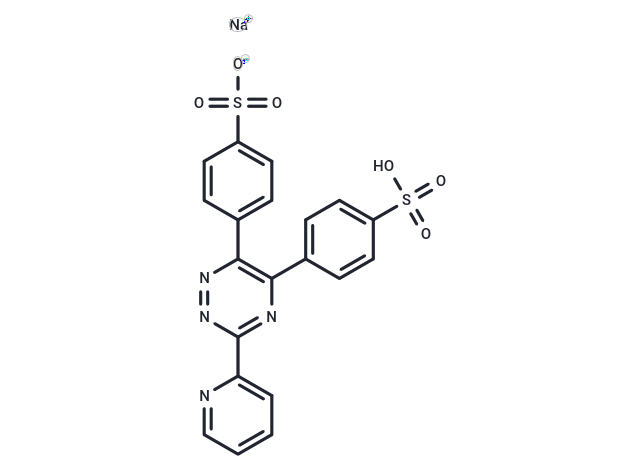Shopping Cart
Remove All Your shopping cart is currently empty
Your shopping cart is currently empty
Ferrozine monosodium salt is a dye that reacts with divalent iron to form a stable magenta complex that can be used for the spectrophotometric determination of iron.

| Pack Size | Price | USA Warehouse | Global Warehouse | Quantity |
|---|---|---|---|---|
| 100 mg | $33 | In Stock | In Stock | |
| 500 mg | $60 | - | In Stock | |
| 1 g | $87 | - | In Stock |
| Description | Ferrozine monosodium salt is a dye that reacts with divalent iron to form a stable magenta complex that can be used for the spectrophotometric determination of iron. |
| Cell Research | I. Determination of the concentration of divalent iron (Fe²⁺) 1. Reagent preparation: Dissolve Ferrozine in water or buffer at a concentration of 0.1-1 mM. Make sure the reagents are freshly prepared. 2. Sample preparation: For biological or environmental samples, a reducing agent (such as ascorbic acid or hydroxylamine hydrochloride) is usually required to reduce Fe³⁺ to Fe²⁺. 3. Reaction: Add the Ferrozine solution to the sample, and Fe²⁺ will react with Ferrozine to form a magenta complex. The reaction usually requires incubation at room temperature for 5-10 minutes. 4. Measurement: Use a spectrophotometer to measure the absorbance of the sample at a wavelength of 562 nm. The absorbance is proportional to the concentration of Fe²⁺ in the sample. 5. Quantification: Compare the absorbance of the sample with a standard curve of known concentrations of Fe²⁺ to determine the iron content in the sample. II. Determination of iron content in biological samples (such as serum, plasma or cells) 1. Sample collection: Collect blood or serum samples and ensure that they are properly processed to ensure the presence of Fe²⁺. 2. Iron extraction (if necessary): For some complex biological samples, it may be necessary to use organic solvents or digestion methods to extract iron. 3. Reaction and measurement: Add Ferrozine solution, follow the general determination method, measure the absorbance at 562 nm after reaction, and quantify the iron content. III. Environmental and water sample analysis 1. Sample preparation: Filter water or environmental samples to remove particles and potential interferences. 2. Reaction: Add Ferrozine solution to the filtered sample, and Fe²⁺ will react with Ferrozine to form a magenta complex. 3. Measurement: Measure the absorbance at a wavelength of 562 nm to determine the iron content in the sample and compare it with the standard curve. IV. Determination of iron content in food and agricultural samples 1. Sample preparation: Homogenize the sample and perform acid digestion to extract iron. 2. Iron reaction: Add Ferrozine solution to the sample extract to form a magenta complex. 3. Spectrophotometric analysis: Determine the absorbance at a wavelength of 562 nm and quantify the iron content based on the standard curve. |
| Molecular Weight | 492.46 |
| Formula | C20H13N4NaO6S2 |
| Cas No. | 69898-45-9 |
| Smiles | O=S([O-])(C1=CC=C(C2=C(C3=CC=C(S(=O)(O)=O)C=C3)N=C(C4=CC=CC=N4)N=N2)C=C1)=O.[Na+] |
| Color | Yellow |
| Appearance | Solid |
| Storage | keep away from direct sunlight | Powder: -20°C for 3 years | In solvent: -80°C for 1 year | Shipping with blue ice/Shipping at ambient temperature. | |||||||||||||||||||||||||
| Solubility Information | DMSO: 20 mg/mL (40.61 mM), Sonication is recommended. | |||||||||||||||||||||||||
Solution Preparation Table | ||||||||||||||||||||||||||
DMSO
| ||||||||||||||||||||||||||
| Size | Quantity | Unit Price | Amount | Operation |
|---|

Copyright © 2015-2026 TargetMol Chemicals Inc. All Rights Reserved.